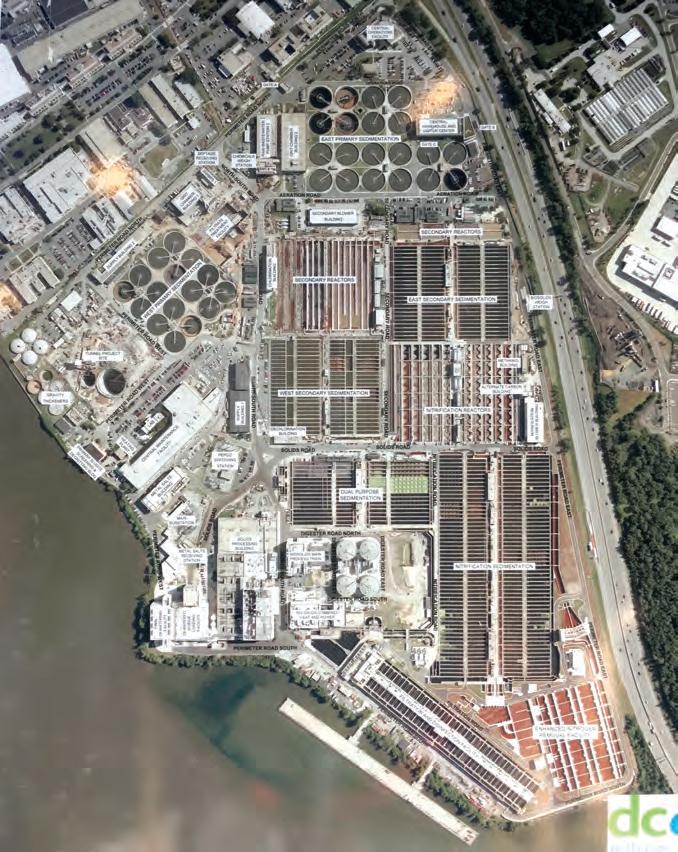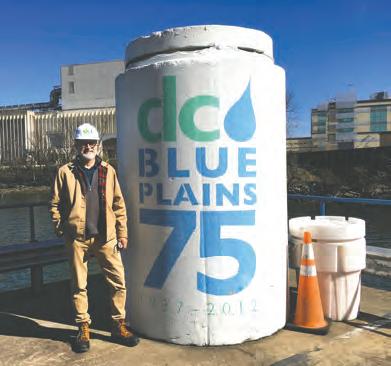
8 minute read
Our River: The Anacostia – Blue Plains; Working For
DCGre n n
Blue Plains - Working For All Of UsOur River: The Anacostia
by Bill Matuszeski
Along the Potomac, virtually in the back yard of Anacostia, is Blue Plains, a remarkable place that we are so lucky to have. Blue Plains is nothing less than “The Largest Advanced Wastewater Treatment Plant In the World.” How it got that recognition and what it does for us is a rather complicated tale, but worth getting to know.
Blue Plains is part of DCWater, which also provides drinking water to 700,000 DC residents plus visitors. In addition to this, it treats wastewater for 1.6 million additional residents of nearby developed areas, including Montgomery, Prince Georges, Fairfax and Loudoun Counties. Blue Plains treats an average of nearly 300 million wastewater gallons per day, has a design capacity for 384 million and a peak capacity with temporary storage of more than a billion gallons per day. David Gadis is the Chief Executive Officer and General Manager of DCWa-
The south end of Blue Plains, where the Cleaned Up Waters are discharged into the Potomac. Photo: Bill Matuszeski

ter. He ensures that DCWater delivers on its commitment to virtually eliminate combined sewer overflows into the Potomac, the Anacostia and Rock Creek. We have already seen amazing results from its $2.7 billion investment in a massive system of deep tunnels and other projects in the Anacostia, with real progress toward the ultimate goal of a 98% reduction of sewer overflows—the highest percentage reduction goal in the metropolitan area, by the way, and among the highest on earth!
So rather than the sewers overflowing into our rivers whenever it rains, they will now deliver near 100% of the overflow to Blue Plains. A tremendous effort is underway to not only treat this sewage, but to develop a range of potential future uses for its components. This effort has produced a range of re-use options under the leadership of Chris Peot, a longtime Capitol Hill resident who is Director of Resource Recovery. During treatment, bio-solids and energy are extracted and reused. The bio-solids are marketed to agriculture and garden supply companies. Other processes in the digesters produce enough electricity to cut the Blue Plains bill by a third.
These are only examples of a full range of innovative treatments that take the plant beyond a “primary” or “secondary” designation and make it an Advanced Wastewater Treatment Plant.
Advanced Treatments
The whole process of this advanced treatment covers a wide range of options and an extended period of time. Key elements are: (1) Screening and Grit Removal: A set of screens removes objects, large particles, rocks and other non-degradables. They are loaded into trucks and taken to a landfill. (2) Primary Clarifiers: In a coneshaped tank, solid particles settle on the bottom, and wastewater flows outward over a set of weirs. Fats, oils and grease are skimmed off the top, solids settle to the bottom, and both are directed to Solids Thickening (see #8.)
(3) Secondary Reactors and Sedimentation: Secondary Treatment is a biological process using activated sludge. The microbes need both oxygen and food. Air is blown into tanks for oxygen. Wastewater contains the food, which the microbes consume and grow more microbes. A portion of the microbes are kept to sustain the process; the rest are recycled with the biosolids. (4) Advanced Treatment: Most treatment plants stop treatment after completing 1,2 and 3 above. What follows establishes Blue Plains’ reputation as an Advanced Wastewater Treatment Facility. (5) Nitrification: The first step is to oxidize the nitrogen from ammonia to nitrate. This is done in nitrification reactors using microbes and a large amount of air. (6) Denitrification: As a second step, the newly formed nitrate is converted to nitrogen gas, which can be safely released to the atmosphere. (7) Multimedia Filtration and Disinfection: The remaining treated plant flow is filtered through sand and anthracite. It is disinfected and residual chlorine is removed. The final plant effluent looks the same as drinking water. (8) Solids Thickening, Dewatering: Solids are removed from the settling tanks, put through grit removal and sent to gravity thickeners. Solids from the secondary and nitrification processes are sent to tanks where they are floated to the surface. The two solids are combined in a blending tank and are de-watered. (9) Thermal Hydrolysis and Anaerobic Digestion: High heat and pressure eliminate pathogens, preparing “food” for the hungry microbes in the digesters, which produce methane and biosolids. The methane is used to fuel turbines, which produce a net 10 megawatts of electricity and steam


YOUR NEIGHBORHOOD REALTOR
GEORGE OLSON
(202) 203-0339 - (M)
(202) 203-0339 - (D) george.olson@cbmove.com
April Showers bring May Flowers! What do May Flowers Bring? HOUSE TOURS!
The JLC Team is proud to be a sponsor of the Capitol Hill Restoration Society’s House & Garden Tour on May 7 - 8, 2022. Buy your tickets today and enjoy a weekend strolling through our beautiful neighborhood looking at fabulous architecture.
Jackie Sink
202.352.5793 jackie.sink@compass.com
Libby Clarke
202.841.1812 libby.clarke@compass.com
Crystal Crittenden
202.246.0931 crystal.crittenden@compass.com
SEE OUR REVIEWS ON ZILLOW JLCTEAM.COM | @JLCTEAM

Compass is a licensed real estate brokerage that abides by Equal Housing Opportunity laws. Information is compiled from sources deemed reliable but is not guaranteed. All measurements and square footages are approximate. This is not intended to solicit property already listed. Compass is licensed as Compass Real Estate in DC and as Compass in Virginia and Maryland. 660 Pennsylvania Avenue SE, Suite 401, Washington, DC 20003 | 202.545.6900
FULL TIME JOB OPENING
Direct Support Professionals
Wholistic Services Inc. is looking for dedicated individuals to work as Direct Support Professionals assisting intellectually disabled adults with behavioral & health complexities in our residential locations in the District of Columbia & Maryland. Job Requirements:

•Ability to lift up to 75 lbs. •Completion of required trainings prior to hire • Completion of Trained Medication Employee (TME) and/or Certified Medication Technician (CMT) Certification(s) within 6 6 months of hire •Cleared DOH background check prior to hire •Valid Driver’s License •Valid CPR & First Aid •Negative COVID-19 test results prior to start of work (taken within 3 days prior to date of hire) •COVID-19 vaccination within 45 days of hire
Due to the pandemic, Wholistic will not accept applications or conduct interviews on-site. Applications must be submitted online. Please contact Human Resources at 202-832-8787 for further information.

Chris Peot, who has the lead at Blue Plains for much of the acti viti es to reuse all the by-products of advanced sewage treatment. Photo: Bill Matuszeski
to feed to other processes. (10) Bio-solids End Use: The bio-solids product is Class A so it can be safely applied in both Urban and rural areas. Much is hauled to farmlands, forests, reclamation projects and local soil blenders who can use it themselves or bag it and sell it through stores with the commercial name “BLOOM.” It is basically returning carbon, nitrogen and phosphorus to the soil. (11) Filtrate Treatment Facility: This group operates the DEMON process, using anammox bacteria to remove nitrogen without using methanol, which saves costs. (12) Enhanced Nutrient Removal: A recent project has reduced further the level of nitrogen discharged into the Potomac. This lower level will reduce the growth of grasses in the River that deplete nitrogen and harm fish habitat. With this in place, Blue Plains is now producing e uents with some of the lowest levels of nitrogen in the country.
All in all, Blue Plains is a very impressive place to visit. And the priorities it sets provide major support for all the e orts to restore the

Reusing all the materials produced by the clean-up is the key to Advanced Treatment; this material becomes a safe ferti lizer for plants of all kinds, from farmers’ crops to home fl ower gardens. Photo: Bill Matuszeski
Anacostia and other rivers in our region. Next time you open your water bill, think of all those wonderful bene ts you are getting from the check you write. And keep pushing for more and faster progress whenever and however you can!
Bill Matuszeski is a member of the Mayor’s Leadership Council for a Cleaner Anacostia River, and the retired Director of the Chesapeake Bay Program. He also serves on the board of Friends of the National Arboretum and on Citizen Advisory Committees for the Chesapeake and the Anacostia. ◆

Tour Blue Plains
If you want to visit and see Blue Plains for yourself, you can sign up now. The tours have been suspended due to Covid, but you can reserve for a future date, and word is the tours are about to reopen. Check www.dcwater.com/ request-tour. Once you are onsite you will be impressed and absorbed by all that is happening to protect our health, the lands and waters around us.


Medical Mobile Massageby Melissa
Licensed Massage Therapist with over 15 years of experience
Bringing the healing power of massage to your home
• Structural Integration & Pain Management Specialist • Proprioceptive Neuromuscular Facilitation • • Manunal Lympahtic Drainage • • Deep Tissue & Sports • • Myofascial Release • • Positional Release Therapy • • Pre and Post Natal Massage










